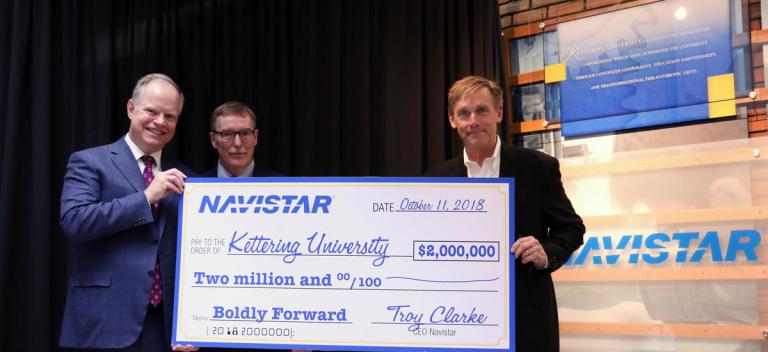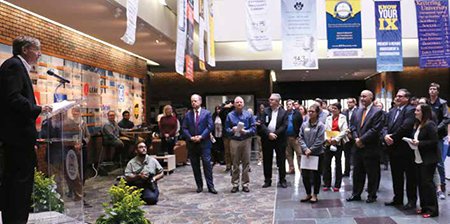
“Many of these students are performing at a high level. We think they will make a contribution to the University and significant contributions to the company and the world as whole.”
When Michael Graham and Daisy Mora began their co-op work at Navistar International, they had no idea their performance would help lead to a $2 million donation from the company to Kettering University.
The gift provides significant opportunities for the University, the company, and the world. The dollars will help build the new Learning Commons on Kettering’s campus, provide renewable scholarships to incoming Kettering students, and generate more funds for research to support the greater good. In turn, Navistar hopes to attract more Kettering graduates.
“Many of these students are performing at a high level,” said Walter Borst ’85, Navistar’s Chief Financial Officer and Executive Vice President. “We think they will make a contribution to the University and significant contributions to the company and the world as a whole.”
Graham was one of Navistar’s first co-op graduates and was soon followed by Mora. Their work earned praise from Borst and the company’s Chairman, President, and CEO Troy Clarke ’78. This positive experience led Graham and Mora to hatch a plan to bring more engineering talent into Navistar, headquartered near Chicago, as it prepares for a changing industry that will in a short time see skyrocketing growth in artificial intelligence, machine learning, and other evolving technologies.
“The scholarship idea was born,” Borst said. “We wanted to get more students to Kettering from Illinois and help students who might not be able to afford to go to Kettering.” To move forward on the plan, Clarke met with Kettering President Dr. Robert K. McMahan. The conversations generated interesting synergies.
For example, Navistar wanted to create more collaboration among its employees. That idea led to a rich discussion about the Kettering University Learning Commons, a new facility the University is raising money to build. Scheduled to break ground in the spring, the Learning Commons will be a place where students learn, collaborate, and create technologies to shape the future. Respectively, Clarke and Borst are creating similar collaborative workspaces within Navistar, and bringing in co-op students already familiar with collaboration is a big plus. “There is something to be said for the process. Things don’t happen by coincidence,” said Clarke.
The discussions also led to the topic of increasing enrollment at Kettering. “We have an opportunity to bring in more students from the Chicago area,” Borst said, pointing out that some future scholarship recipients could come from the FIRST Robotics teams that Navistar supports. The company sponsors eleven teams.
“These students have an early sense of what they want to do in life,” Borst continued. Navistar would like to see many of them join its ranks. The opportunities that evolve from the FIRST Robotics experience benefit everyone involved. This year, to enhance the FIRST Robotics students’ educations and perhaps their own as well, Borst, Clarke, and other employees will be part of a “reverse mentoring” program where the students will be the mentors and judges.
With research being important to Navistar, the Kettering University GM Mobility Research Center (MRC) is a strong interest. MRC, which is a state-of-the-art research facility and proving ground, is one of only a handful of its kind in the world and the only one of its kind on a college campus in the country. MRC connects Navistar to an expanding market that includes commercial advanced driver assistance systems and advanced driving or autonomous vehicles, areas where Navistar sees valuable growth potential. “Our company is very much aligned with Kettering’s vision,” Clarke said.
 Navistar and Kettering University established their relationship with Navistar’s $2 million pledge in fall 2018. The gift will be distributed with $1 million for the new Learning Commons, $750,000 to support research initiatives, and $250,000 to establish Kettering scholarships for students from the state of Illinois. “We are creating a long-term relationship,” Clarke said. “This is the first installment of what we can do together. Let’s think of it as we are funding the first phase of what will evolve over time.”
Navistar and Kettering University established their relationship with Navistar’s $2 million pledge in fall 2018. The gift will be distributed with $1 million for the new Learning Commons, $750,000 to support research initiatives, and $250,000 to establish Kettering scholarships for students from the state of Illinois. “We are creating a long-term relationship,” Clarke said. “This is the first installment of what we can do together. Let’s think of it as we are funding the first phase of what will evolve over time.”
Today, Navistar has 16 Kettering co-op students in a program run by Jim Stanick ’84, Director of Body Engineering. Seven students work in integrated product development, with the others in information technology, cyber security, and finance. For the first three years, the product development students are rotated through engineering purchasing, quality, testing, and manufacturing, so they get a start-to-finish look at all that is involved in the process. Their remaining time provides an opportunity to concentrate on their thesis. Students working in other departments rotate jobs in a similar pattern.
Throughout the co-op experience, Stanick spends time talking with the students about their personal interests, soliciting their feedback, and making sure they are equipped with a holistic knowledge of Navistar. “We are building the future of Navistar,” he said. “When the students graduate, we want to have given them such opportunity that it is natural for them to stay. We are trying to create engineers and managers who will have a significant role in how this company runs and who can’t see themselves working anywhere else.”